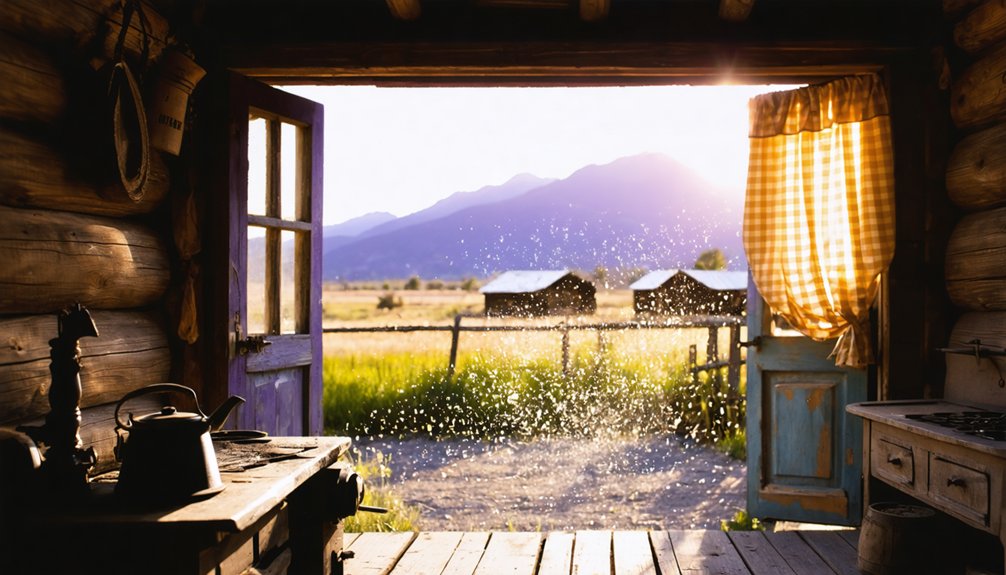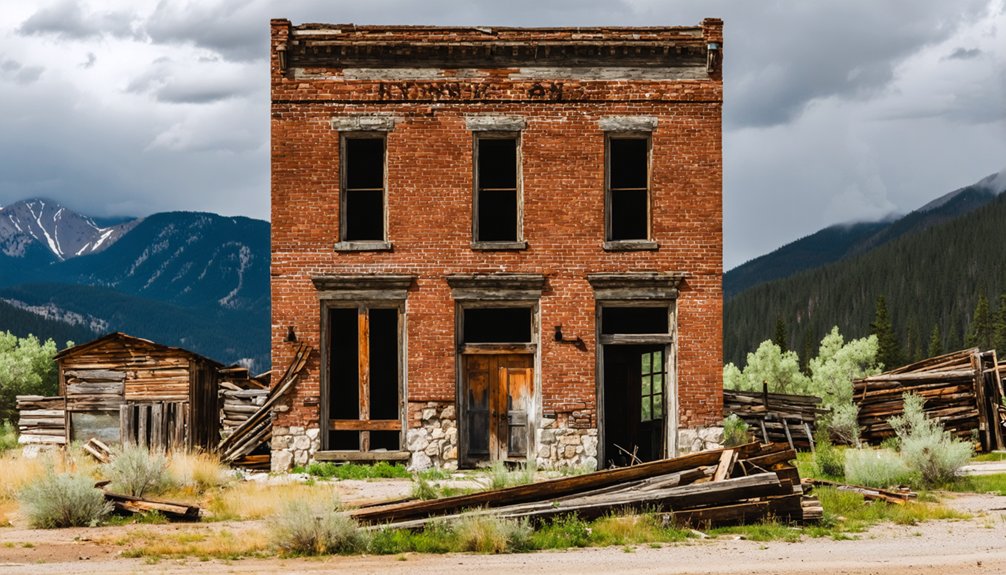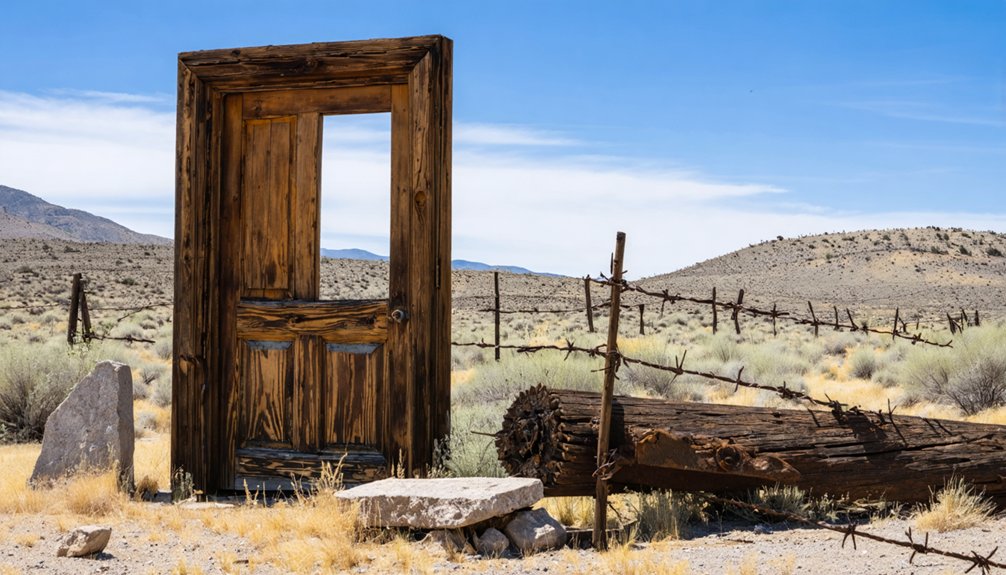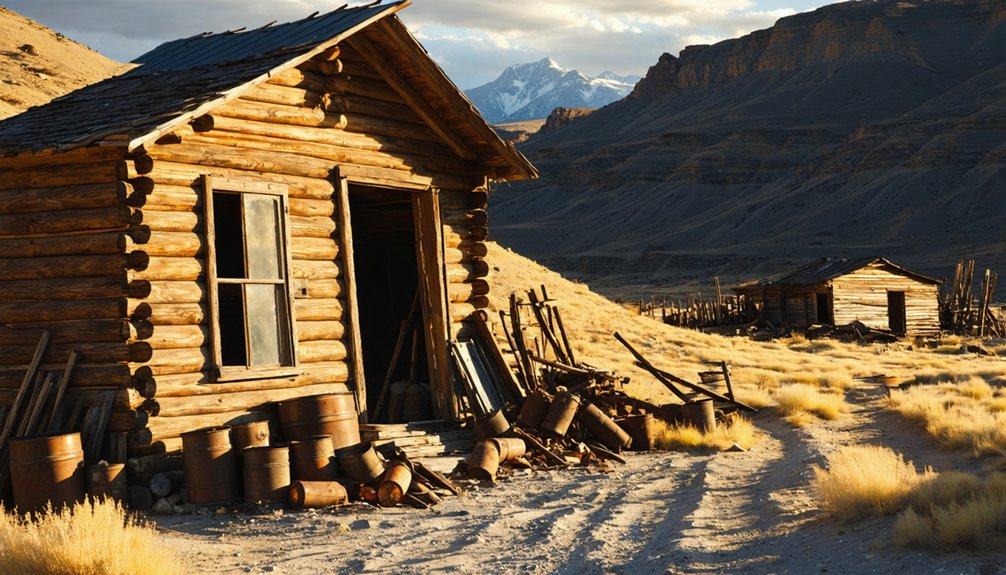In Idaho’s Wood River Valley, you’ll find the remnants of Muldoon, a once-bustling silver mining town that peaked in the 1880s with 1,500 residents. The town boasted modern amenities like electric lighting, a post office, and two 40-ton smelters that processed valuable ore worth $200,000 between 1882-1884. Today, you can explore the scattered ruins, including a slag pile and partial kiln structure, though you’ll need a sturdy vehicle to navigate the swampy terrain. The site’s rich history awaits beneath its overgrown landscape.
Key Takeaways
- Muldoon was a thriving silver mining town in Idaho’s Wood River Valley that peaked with 1,500 residents in the early 1880s.
- The town featured modern amenities including electric lighting, a post office, hotel, schoolhouse, and two 40-ton smelters.
- Despite $75,000 in Philadelphia investments and advanced mining technology, technical difficulties led to the town’s economic decline.
- The town’s downfall was marked by a sheriff’s auction of the smelter in 1887 during the International Silver Depression.
- Today, Muldoon is a ghost town with only scattered ruins, including a slag pile, partial kiln, and one deteriorating miner’s cabin.
The Silver Rush That Started It All
While Idaho’s mining legacy traces back to the 1860 gold discovery on the North Fork of the Clearwater River, it was the silver rush of the 1880s that transformed the Wood River Valley and gave birth to Muldoon.
As you explore the rich history of this region, you’ll find that silver discoveries in the Little Wood River Valley sparked an unprecedented wave of fortune seekers in 1881. The area’s abundant silver and lead deposits quickly established Muldoon as a thriving mining community, joining other booming districts across southern Idaho. The town rapidly grew to include two 40-ton smelters that processed the valuable ore.
Mining legacy runs deep throughout the Coeur d’Alene Mountains and Silver Valley, where prospectors employed various techniques from placer mining to more sophisticated operations. The rush brought thousands to these remote valleys, spurring rapid development of towns and infrastructure that would shape Idaho’s future. By 1903, the region’s mining prowess was evident as Burke Canyon emerged as the most developed mining area with seven dividend-paying mines.
Life in a Booming Mining Town
During its peak in the early 1880s, Muldoon bustled with nearly 1,500 residents who transformed the remote mining outpost into a thriving frontier community.
You’d find miners living in hastily built cabins and boarding houses, gathering at the town’s saloons after their grueling shifts at the mines and smelters. The town boasted modern amenities for its time, including electric lighting by 1882 and essential services like a post office, hotel, and schoolhouse. The silver and lead mined from Idaho Muldoon Mine sustained the local economy for years.
Community gatherings centered around the saloons, which served as social hubs where residents could escape the harsh realities of frontier life. Like other mining towns of the era, Muldoon faced severe challenges during the International Silver Depression that devastated many similar communities.
Social dynamics revolved around the mining schedule, with stagecoach connections keeping the town linked to neighboring communities. While basic infrastructure remained minimal, you’d witness a determined community supporting itself through privately managed utilities and a network of 23 nearby charcoal kilns.
Mining Operations and Economic Impact
You’ll find that Muldoon’s mining infrastructure was quite advanced for its time, featuring two water jacket furnaces from San Francisco that could process 80 tons of ore daily and an early electric lighting system that predated installations in larger towns like Hailey and Boise.
While the operation extracted significant silver and lead deposits, producing about $200,000 worth of ore between 1882 and 1884, financial challenges persisted despite Philadelphia investors committing $75,000 to construct smelters and a 1,200-foot tram system.
The economic fragility of the mining venture became evident when technical difficulties in ore recovery led to workforce reductions and ultimately culminated in the smelter’s sheriff’s auction in 1887, marking the beginning of the town’s decline.
Mining Technology and Equipment
As Muldoon established itself in 1882, the mining camp quickly embraced cutting-edge technology with the installation of an electric light plant that preceded similar facilities in larger towns like Hailey and Boise.
The camp’s mining innovations included two 40-ton water jacket furnaces from San Francisco’s Pacific Iron Works, though one proved sufficient for production needs.
You’ll find evidence of their advanced smelting processes in the sophisticated tram system that transported ore 1,200 feet vertically from the mine.
Like many mines during the lead-silver boom, Muldoon’s operations contributed to southern Idaho’s rapid industrial development in the 1880s.
The operation’s technical prowess extended to its charcoal pits and sawmills, which supported the smelting operations.
Despite these advances, the mine struggled with ore recovery systems and reached 900 feet in depth before hitting a geological fault that challenged even the period’s best equipment.
Silver Production Records
While Muldoon’s technological advances were notable, the mine’s production records tell a more modest story.
You’ll find that during its prime years of 1881-1886, the mine yielded approximately $200,000 in silver-lead ore value – worth about $1.2 million in today’s currency. The ore composition featured impressive grades typical of the region, averaging around 13.4 ounces of silver per ton.
The ore deposits occurred as replacement deposits along bedding with distinctive mineral assemblages.
- Primary production occurred before 1900, representing 75% of the district’s total output
- Silver-lead grades were complemented by zinc, copper, and trace amounts of barite
- Main ore minerals included chalcopyrite and sphalerite alongside silver-bearing compounds
- Operations focused on replacement-type deposits within folded sedimentary rocks
- Peak production years yielded the highest-grade ore, with quality declining in later periods
Financial Rise and Fall
When Philadelphia investors poured $75,000 into Muldoon’s mining infrastructure in 1881, they envisioned creating one of Idaho Territory’s most advanced silver-lead operations.
Their investment strategies included installing two water jacket furnaces, building a sophisticated tram system, and establishing charcoal kilns to support smelting operations.
Despite initial promise and cutting-edge technology, Muldoon’s path to economic sustainability proved challenging.
While the smelters could process 40 tons of ore daily, technical difficulties with the tram system delayed production until September 1882.
By year’s end, the workforce had dwindled to just 16 miners.
The operation’s total mineral production reached only $200,000 between 1882 and 1910, falling far short of investors’ expectations.
The venture ultimately ended with a sheriff’s auction of the smelter.
Daily Life and Community Spirit

The bustling mining town of Muldoon fostered a tight-knit community where 1,500 residents relied on each other to navigate the challenges of frontier life. Located forty miles west of local trapper Laf Yellowhair’s cabin, the town served as a vital silver mining hub.
Community bonds formed through shared experiences at the local hotel, saloons, and schoolhouse, where daily routines brought people together despite the harsh Idaho environment.
- You’d find children learning at the schoolhouse while parents worked in the mines or ran local businesses.
- The post office served as a crucial hub for staying connected with the outside world.
- Merchants and service providers kept the town functioning through seasonal changes.
- Social gatherings at the hotel and saloons strengthened neighborly relationships.
- Community members pooled resources and skills to maintain shared amenities.
The town’s spirit lived through its people’s determination to build a thriving community despite isolation and challenging conditions.
The Rise and Fall of Muldoon’s Smelters
Behind Muldoon’s community spirit lay its economic engine – two massive 40-ton smelters that transformed the remote Idaho settlement into a modern mining powerhouse.
You would’ve marveled at the sophisticated smelting techniques employed by the water jacket furnaces, imported from San Francisco’s Pacific Iron Works.
The Philadelphia & Idaho Mining & Smelting Company’s million-dollar mining investments created an impressive infrastructure, including a two-mile tram system that transported ore 1,200 feet down from the mines.
The company processed ores containing galena with silver and other valuable minerals that yielded significant profits for investors.
The arrival of the Oregon Short Line Railroad in 1883 sparked significant expansion of smelting operations in the region.
Notable Buildings and Infrastructure

Standing proudly at its peak, Muldoon’s infrastructure supported a bustling community of 1,500 residents with modern amenities rare for a frontier mining town.
You’d have found an impressive array of community amenities highlighting Muldoon’s historical significance:
- A fully operational post office connecting residents to the outside world
- Multiple saloons and stores serving as vibrant social and commercial hubs
- A schoolhouse demonstrating the town’s commitment to education
- A hotel accommodating visitors and temporary workers
- Two 40-ton smelters with sophisticated brick kilns powering the economy
Financial troubles led to the smelter’s sheriff auction in 1887, marking the beginning of the town’s decline.
Today, you’ll find only scattered ruins where these structures once stood.
The remaining brick kiln remnants and black slag pile serve as silent witnesses to Muldoon’s ambitious infrastructure, reminding us of a once-thriving Idaho mining community.
The Town’s Decline and Abandonment
Muldoon’s financial troubles began in 1887 when its primary smelter was sold at a sheriff’s auction, signaling the start of the town’s rapid decline.
You’ll find that the collapse of silver prices in the 1890s dealt another devastating blow to the mining community, making most operations unprofitable and forcing many residents to seek opportunities elsewhere.
The town’s population of 1,500 dwindled quickly as miners and their families abandoned their homes, leaving behind a once-bustling settlement that had proudly boasted electric lights before larger cities like Boise.
Financial Troubles Begin
Despite early production values reaching $345,000 by 1883, the town’s financial troubles began when operators couldn’t develop an adequate ore recovery system.
Financial constraints and mining inefficiencies quickly led to operational challenges that would ultimately seal Muldoon’s fate.
You’ll find these key factors contributed to the town’s early financial decline:
- High transportation costs from hauling ore 26 miles to railheads
- Limited water availability that shortened mining seasons
- Inefficient ore processing that reduced potential profits
- Maintenance struggles with essential charcoal kilns
- Significant infrastructure deterioration over time
The severity of these issues became clear when the smelter, crucial to the town’s operations, was sold at a sheriff’s auction in 1887.
This marked a turning point, signaling the beginning of Muldoon’s economic collapse.
Population Exodus Accelerates
After the closure of Muldoon’s smelter at a sheriff’s auction in 1887, the town’s once-vibrant population of 1,500 residents began a rapid exodus.
The population dynamics shifted dramatically as miners and their families left in search of new opportunities, leaving behind the modern amenities they’d enjoyed including electric lighting, hotels, and various merchants.
What Remains of Muldoon Today

When visiting the once-bustling mining town of Muldoon today, you’ll find only sparse remnants of its former glory scattered across a swampy, overgrown landscape.
Nature has steadily reclaimed this historic site, transforming the ghost town remnants into an environmental reclamation showcase. You can still explore these surviving features:
- A substantial slag pile and partial kiln structure marking the town’s industrial heart
- One deteriorating miner’s cabin, slowly succumbing to the elements
- Flooded building foundations with collapsed concrete slabs nearby
- Dense old-growth forest and underbrush covering former town streets
- Scattered cement fragments and mining equipment ruins throughout the site
Access requires a sturdy vehicle, and you’ll need to navigate carefully through the swampy basin that’s replaced much of the original townsite.
The minimal preservation efforts mean you’re witnessing history in its raw, untamed state.
Frequently Asked Questions
What Was the Average Temperature and Climate in Muldoon During Its Peak?
You’d experience cool year-round temperature trends, from snowy winters below freezing to mild summers in the 70s-80s°F, with distinct seasonal climate conditions shaped by the mountainous environment.
Were There Any Major Accidents or Disasters During Muldoon’s Mining Operations?
You won’t find major accident reports or disaster recovery records for mining operations here – available historical records and government databases don’t document any significant mining catastrophes in this small silver-lead district.
How Did Mail Service Operate Between Muldoon and Other Idaho Towns?
You’d find mail routes connected through stagecoaches and freight wagons, with Neil Campbell’s line running an essential 26-mile postal history link between Muldoon and Bellevue’s railroad hub starting in 1882.
What Happened to the Mining Equipment After the Town Was Abandoned?
Massive machinery met misfortune when floods destroyed most mining relics. You’ll find equipment was either sold to nearby mills, washed away in catastrophic flooding, or buried beneath mud-filled tunnels, preventing equipment restoration.
Did Any Famous or Notorious Individuals Ever Visit or Live in Muldoon?
You won’t find documented evidence of famous visitors or notorious residents living in Muldoon itself, though the nearby McFall Hotel hosted Butch Cassidy, Ernest Hemingway, and several U.S. Presidents.
References
- https://www.youtube.com/watch?v=yjrkoTqOQFM
- https://history.idaho.gov/wp-content/uploads/2018/08/0064.pdf
- https://npshistory.com/publications/blm/historic-mines-blaine-co.pdf
- https://www.johnwlundin.com/idaho-history/
- https://www.ghosttowns.com/states/id/muldoon.html
- https://www.idahogeology.org/pub/Bulletins/B-22.pdf
- https://valleychamber.org/idaho-mines/
- https://en.wikipedia.org/wiki/Silver_Valley_(Idaho)
- https://idahodocs.contentdm.oclc.org/digital/api/collection/p16293coll3/id/183924/download
- https://pubs.usgs.gov/bul/b2064-t/b2064-t.pdf



